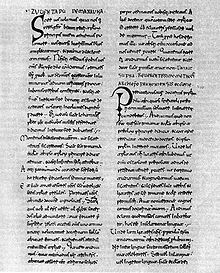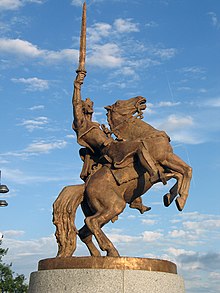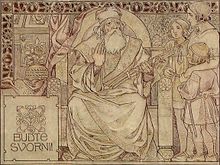Svatopluk I (Moravia)
Svatopluk I. or Svätopluk I. ( Latin : Zwentibald , Old Slavonic : Свѧтопълкъ ., Scientific transliteration Svętopъłkъ , Greek : Sphendoplokos , Slovak : Svätopluk I. * unknown, † 894 ) from the Moravian ruler dynasty of the house of mojmir was of 870/71 until 894 the prince ( dux ) of Moravia , but from the mid-880s he is also referred to as king ( rex ) in contemporary sources .
After he had provisionally agreed with the Eastern Franks in the Peace of Forchheim in 874 , Svatopluk began a policy of conquest and Christianization towards the neighboring Slavic tribes, which later increasingly also affected Eastern Franconia. As a result, Moravia experienced its greatest territorial expansion and the rise to a central European great power.
In terms of ecclesiastical politics, Svatopluk advocated a good relationship with the Pope and in 880 placed Moravia under papal patronage, whereby the Holy See placed him de facto on a par with the East Frankish kings. As a supporter of the Latin clergy, after the death of the Moravian Archbishop Method, at the behest of Pope Stephen V in 885 , Svatopluk had the Old Slavic liturgy in his kingdom, which had been introduced under his predecessor Rastislav , and approved the expulsion of the Slavic priests from his empire Country.
After Svatopluk's death in 894 he was succeeded by his sons Mojmir II and Svatopluk II as Moravian rulers.
Origin and political career until 870
Svatopluk is first mentioned in contemporary sources in 869. At this time he already ruled over his own "regnum", which in Franconian terminology referred to a sovereign (if not always independent) area of a ruler. This "regnum" is located in what is now western Slovakia , its center is believed to be either at Bratislava Castle or at Nitra . This “regnum” was devastated by Karlmann's army in 869 . Svatopluk is referred to here as Rastislav's nephew. He is also mentioned in the papal bulls of Pope Hadrian II of 869 and 870. In the first bull, the Pope confirmed the use of the Slavic liturgy and sent Method to Moravia as his legate for the Slavic countries. The second dealt with the posting of Methods as archbishop for the countries of Rastislav, Svatopluks and Kocels.
In 867, after intense attacks from East Franconia, Rastislav made Svatopluk the feudal lord of the principality of Nitra. This should improve the defense against the Eastern Franks and Svatopluk's political power grew. In fact, the Moravian Empire was divided into two parts. Both Rastislav and Svatopluk had to repel further attacks in 868 and 869.
Prince of Moravia (870 to 894)

Foreign and conquest policy
In 870, however, Svatopluk placed his principality under the protection of the East Franconian Empire and denounced Rastislav's obedience. This tried to murder Svatopluk and regain his influence on his principality. However, Sventopluk for his part succeeded in capturing Rastislav and then surrendering him to the Eastern Franks ( Carolingians ) as Rastislav's long-term opponents. Rastislav was blinded due to a court ruling and died in a Bavarian monastery .
The Franks also sent their own people (Count Wilhelm II and Engelschalk I) as regents in Rastislav's empire (i.e. western Moravia). Svatopluk in Slovakia (East Moravia), who had hoped to rule over the entire Moravian Empire himself, did not want to accept this East Franconian occupation. However, he was imprisoned with the holy Method .
In 871 there was a popular uprising in the Moravian Empire as a result of the imposed Franconian rule . Its leader was probably a certain Slavomír . Ludwig the German sent an army to suppress the uprising, but it was defeated. Thereupon Ludwig organized a second platoon led by Svatopluk, who had been released from prison. This promised the Frankish ruler to put down the uprising. When the Frankish army reached the Moravian stronghold, Svatopluk went over to the rebels and took over the command. The Frankish army was crushed and Svatopluk was able to become prince of the Moravian Empire.
Svatopluk had to repel Frankish attacks in 871 and 872. In 874, the Forchheim peace was concluded between the ambassadors Svatopluks and Ludwig the German . Svatopluk undertook to pay taxes to the East Frankish Empire and formally recognized its rule. Nevertheless, due to the calm with his strongest opponent, he now had the opportunity to enlarge the area of the Moravian Empire and to convert it into an empire . The expansion was simplified by the cultural achievements. As early as 874 he owned the area along the upper course of the Vistula River . He also took what is now northern Moravia around Opava . In 880 Silesia and 881 today's eastern Hungary on the middle Tisza (at that time Bulgarian area) were added, from 890 also Bohemia (Principality of the Přemyslids ) and Lausitz (Lusatian Sorbs ) were part of his empire.
In 882 Svatopluk fell as an ally of the East Franconian ruler Charles III. into the Bavarian Ostmark and chased away the margraves Wilhelm and Engelschalk. These allied with Arnulf of Carinthia in Pannonia, who allied against Svatopluk with the Bulgarians . Svatopluk defeated Bulgaria and even joined the Pannonian Principality - part of the territory of Arnulf of Carinthia - to his empire in 883 and 884 . He took this step from Charles III. with a contract in the summer of 884 on the Chuomberg (mons Comianus) near the Vienna Woods . At the same time, a peace between Eastern Franconia and the Moravian Empire was negotiated again, and the position of the Moravian ruler was further strengthened. In 885 Svatopluk also reconciled himself with Arnulf - on the one hand because it was already clear that Arnulf would become the new East Frankish king (887) and on the other hand because Svatopluk was the godfather of Arnulf's illegitimate son Zwentibold (Zuentibold, i.e. Svatopluk), who later became King of Lorraine , was. Despite the peace, there were again conflicts between Arnulf of Carinthia and Svatopluk because of pannonia in 888 and 889. It was through that Zuentibold that today's Slovak national coat of arms, brought to Slovakia by Cyril and Methodius, came to Lorraine as the so-called Lorraine cross.
In 888 the Přemyslid Bořivoj I died and Svatopluk took over direct power in Bohemia as substitute for Bořivoj's underage sons. The takeover of power was confirmed by King Arnulf in 890 on the Omuntesperch (Amandhegy-Pannonhalma or Omuntesdorf). However, Arnulf annulled the treaty in 892 and moved with his allies, this time reinforced by Hungary, against Svatopluk. These and two other attacks in 892 and 893 were suppressed by the Moravian Army Commander.
Church politics
Main article: Method of Saloniki
Svatopluk carried out significant social and military reforms. The Moravian Empire thus confirmed its strong position in Central Europe . The Moravian ecclesiastical administration was also reformed in 880. The diocese in Nitra with Bishop Wiching (a Swabian monk) who was subordinate to Archbishop Method was decisive . In the same year the Moravian Empire became a fiefdom of the Holy See . This meant an equal position as the East Franconian Empire. Svatopluk himself thus became de iure king (although he was sometimes referred to as rex before ). About a year later, the first monastery in present-day Slovakia was founded in Nitra (Neutra). In the year 880 he was addressed by Pope John VIII as the only Slavic ruler in history in a letter with the imperial address "only son" (unicus filius).
Towards the end of his rule, the Pope banned the Slavic liturgy Methods ( Old Church Slavonic ) after a complicated development and after Method's death (885) . In 886 Wiching and papal envoys banished the students of Methods from the Moravian Empire. In 891 Wiching left Nitra and went to Eastern France, where he later became Chancellor of the Kaiser.
Svatopluk himself remained rather neutral in these ecclesiastical disputes, but personally - as a papal letter explicitly confirms - he preferred the Latin liturgy. In the end he supported Wiching and the Latin priests. In 885 Pope Stephen V again forbade the use of the Slavic language in the liturgy.
Death and succession
Prince Svatopluk died in 894. On his deathbed he urged his sons to resist the East Franks. He encouraged them to try to keep power in the Moravian Empire.
His first son Mojmir II became ruler of the empire after Svatopluk's death. The second son Svatopluk II received the principality of Nitra as a fief and the third son Predslaus probably Bratislava (Pressburg). After 894 there were disputes between Mojmir II and Svatopluk II and the collapse of the Moravian Empire began.
reception
The opera Kráľ Svätopluk (King Svatopluk) by the Slovak composer Eugen Suchoň , completed in 1959 and premiered in Bratislava in 1960, is about Svatopluk's life. The libretto was written by Ivan Stodola, Eugen Suchoň and Jela Krčméry. Based on the opera, the film Svätopluk followed in 1989 , directed by the Slovak director Jozef Zachar .
In 2010, the Slovak Prime Minister Robert Fico (2006–2010 and 2012–) unveiled a monumental equestrian statue of Svatopluks I at Bratislava Castle , which was directed particularly against Hungary. It is particularly emphasized that Svatopluk I lived and ruled before the Hungarian King Stephen I , as a rejection of the territorial claims of Hungarian nationalists. That is why on June 6, 2010, six days before the parliamentary elections in Slovakia in 2010 (and on the 90th anniversary of the Trianon Treaty ), an equestrian statue of Svatopluk was unveiled in the presence of the Prime Minister, the Speaker of the Parliament and the President of the Republic - which met with strong criticism from activists and Artists came across. Above all, the choice of the sculptor Ján Kulich, who appeared as one of the leading figures in normalization (1969–89), was criticized. The placement (Bratislava Castle) and the fact that other parties besides the ruling Smer-SD party were almost absent were also noted.
Individual evidence
- ↑ Havlík: Svatopluk Veliký , p. 27.
- ↑ Třeštík: Vznik Velké Moravy , S. 195th
- ↑ Havlík: Svatopluk Veliký , p. 27.
- ↑ Havlík: Kronika , p. 215.
- ↑ - ( Memento of the original from September 24, 2015 in the Internet Archive ) Info: The archive link was inserted automatically and has not yet been checked. Please check the original and archive link according to the instructions and then remove this notice.
- ↑ http://derstandard.at/1250691597172/Diplomatischer-Streit-Fico-will-Statuen-slowakischer-Patrone-in-Grenzstadt-Komarno?sap=2&_seite=2
- ↑ http://www.pesterlloyd.net/2009_28/0928slow/0928slow.html
- ^ Rudolf Hermann, Prague: Farce about an equestrian statue. In: nzz.ch. June 9, 2010, accessed October 14, 2018 .
- ↑ http://spectator.sme.sk/articles/view/39150/10/young_artists_protest_against_the_creator_of_a_new_svatopluk_statue_in_slovakia.html
- ↑ http://spravy.pravda.sk/pred-hradom-uz-drzi-straz-svatopluk-od-sochara-komunizmu-pmn-/sk_domace.asp?c=A100606_224040_sk_domace_p29
- ↑ http://spravy.pravda.sk/deklarovana-jednota-nebola-na-odhalenie-sochy-prisli-len-lidri-smeru-1ip-/sk_domace.asp?c=A100607_144632_sk_domace_p23
- ↑ Deep abrasions Ender dispute over an equestrian statue ( Memento of 24 September 2015, Internet Archive ), Südwestpresse from August 7, 2010
literature
- Witold Chrzanowski: Świętopełk I Wielki, król Wielkomorawski (ok.844–894) [Svatopluk I the Great, King of Great Moravia.] Kraków 2010, ISBN 978-83-60448-88-5 . (Polish)
- Lubomír E. Havlík: Svatopluk Veliký, král Moravanů a Slovanů [Svatopluk the Great, King of the Moravians and Slavs.] Jota, Brno 1994, ISBN 80-85617-19-6 . (Czech)
- Lubomír E. Havlík: Kronika o Velké Moravě [Chronicle of Great Moravia]. JOTA, o. O. 2013, ISBN 978-80-8561-706-1 . (Czech)
- Matúš Kučera: Kráľ Svätopluk [King Svätopluk.] Matica slovenská, Martin 2010, ISBN 978-80-7090-965-2 . (Slovak)
- MacLean, Simon. Kingship and Politics in the Late Ninth Century: Charles the Fat and the end of the Carolingian Empire . Cambridge University Press: 2003.
- Ján Steinhübel: Nitrianske kniežatstvo. Počiatky stredovekého Slovenska [The Principality of Nitra. The Beginnings of Medieval Slovakia]. Rak, Bratislava 2004, ISBN 80-224-0812-3 . (Slovak)
- Dušan Třeštík: Počátky Přemyslovců. Vstup Čechů do dějin (530–935) [The beginnings of the Přemyslids. The Entry of the Czechs into History (530–935)]. Nakladatelství Lidové noviny, o. O. 2008, ISBN 978-80-7106-138-0 . (Czech)
- Dušan Třeštík: Vznik Velké Moravy. Moravané, Čechové a střední Evropa v letech 791–871 [The emergence of Great Moravia. Moravians, Czechs and Central Europe in the years 791–871]. Nakladatelství Lidové noviny, o. O. 2010, ISBN 978-80-7422-049-4 . (Czech)
Web links
| predecessor | Office | successor |
|---|---|---|
| Rastislav |
Prince of Moravia 870–871 |
Slavomir |
| Slavomir |
Prince of Moravia 871–894 |
Mojmir II |
| Bořivoj I. |
Prince of Bohemia 888–894 |
Spytihněv I. |
| personal data | |
|---|---|
| SURNAME | Svatopluk |
| ALTERNATIVE NAMES | Sventopluk; Svätopluk; Святополкъ; Świętopełk; Zventapu; Zwentibald; Zuendibolch; Suatopluk |
| BRIEF DESCRIPTION | third ruler of the Great Moravian Empire |
| DATE OF BIRTH | around 830 |
| DATE OF DEATH | 894 |





